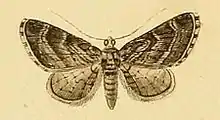| Eupithecia ericeata | |
|---|---|
 | |
| Scientific classification | |
| Domain: | Eukaryota |
| Kingdom: | Animalia |
| Phylum: | Arthropoda |
| Class: | Insecta |
| Order: | Lepidoptera |
| Family: | Geometridae |
| Genus: | Eupithecia |
| Species: | E. ericeata |
| Binomial name | |
| Eupithecia ericeata | |
| Synonyms | |
| |
Eupithecia ericeata is a moth in the family Geometridae first described by Jules Pierre Rambur in 1833. It is found in most of southern Europe and the Near East.[2]
The wingspan is about 17–19 mm.[3] Adults are variable, ranging from a typical light form with a distinct pattern on the forewings to a unicolorous melanistic form.[4]
Subspecies
- Eupithecia ericeata ericeata
- Eupithecia ericeata euxinata Bohatsch, 1893 (Ukraine, Greece)
References
Wikimedia Commons has media related to Eupithecia ericeata.
Wikispecies has information related to Eupithecia ericeata.
- ↑ Yu, Dicky Sick Ki. "Eupithecia ericeata (Rambur 1833)". Home of Ichneumonoidea. Taxapad. Archived from the original on March 25, 2016.
- ↑ Fauna Europaea
- ↑ Lepiforum e.V.
- ↑ New species of Eupithecia Curtis (Geometridae: Larentiinae) from Syria Archived 2014-07-14 at the Wayback Machine
- ↑ Moths and Butterflies of Europe and North Africa
This article is issued from Wikipedia. The text is licensed under Creative Commons - Attribution - Sharealike. Additional terms may apply for the media files.